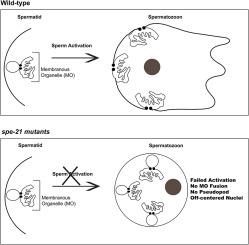编码棕榈酰转移酶的秀丽隐杆线虫spe-21基因是精子发生所必需的
IF 2.1
3区 生物学
Q2 DEVELOPMENTAL BIOLOGY
引用次数: 0
摘要
在大多数动物中,产生的精子在完成减数分裂后必须进一步分化为具有受精能力的精子。在秀丽隐杆线虫中,这个过程被称为精子发生或精子活化,它导致圆形的、不能运动的精子细胞转变为变形虫状的、能运动的精子。秀丽隐杆线虫的精子激活也与高尔基衍生囊泡(称为膜细胞器(MOs))与质膜的融合有关。这种融合过程是通过将携带mo的常驻蛋白放置在精子膜上,在精子表面产生受精能力所必需的。我们已经鉴定、克隆并鉴定了spe-21(也称为dhhc-5)在雌雄同体和雄性精细胞激活过程中的作用。假定的spe-21零突变虫在所有研究的生长温度下都严重欠育。在用已知的化学激活剂处理后,Spe-21突变精子不能在体内或体外激活。我们发现spe-21是精子MO融合和假足形成所必需的。spe-21基因编码一个保守的Asp-His-His-Cys (DHHC)四肽锌指基序嵌入富含半胱氨酸的区域(DHHC- crd型锌指基序)的四通跨膜蛋白。通常,具有DHHC-CRD基元的蛋白质催化翻译后棕榈酸酯在其蛋白质底物上的加成,被称为棕榈酰基转移酶或棕榈酰基转移酶(PATs)。我们还发现mneongreen标记的SPE-21定位于精子中的MOs。总之,我们的研究结果表明,SPE-21是一种MO定位的棕榈酰基转移酶,是精子激活和产生具有受精能力的精子所必需的。本文章由计算机程序翻译,如有差异,请以英文原文为准。

The Caenorhabditis elegans spe-21 gene that encodes a palmitoyltransferase is necessary for spermiogenesis
In most animals, spermatids that are produced must further differentiate into fertilization-competent spermatozoa after completing meiosis. In Caenorhabditis elegans, this process is known as spermiogenesis or spermatid activation and it results in the transformation of round, non-motile spermatids into amoeboid, motile spermatozoa. Spermatid activation in C. elegans is also associated with the fusion of Golgi-derived vesicles called the membranous organelles (MOs) with the plasma membrane. This fusion process is required for producing a fertilization-competent surface on the sperm by placing MO-carried, resident proteins onto the spermatozoon membrane. We have identified, cloned, and characterized the role of spe-21, also designated as dhhc-5, during both hermaphrodite and male spermatid activation. Putative spe-21 null mutant worms are severely sub-fertile at all studied growth temperatures. spe-21 mutant spermatids fail to activate either in vivo or in vitro after treatment with known chemical activators. We have found that spe-21 is necessary for MO fusion and pseudopod formation in spermatids. The spe-21 gene encodes a predicted four pass transmembrane protein with a conserved Asp-His-His-Cys (DHHC) tetrapeptide zinc finger motif embedded in a cysteine rich region (DHHC-CRD type zinc finger motif). Generally, proteins with DHHC-CRD motifs catalyze the post-translational addition of palmitate to their protein substrates and are called palmitoyltransferases or palmitoylacyltransferases (PATs). We also found that mNeonGreen-tagged SPE-21 localizes to the MOs in spermatids. Together, our findings show that SPE-21 is an MO localized palmitoyltransferase required for proper spermatid activation and creation of fertilization-competent spermatozoa.
求助全文
通过发布文献求助,成功后即可免费获取论文全文。
去求助
来源期刊

Developmental biology
生物-发育生物学
CiteScore
5.30
自引率
3.70%
发文量
182
审稿时长
1.5 months
期刊介绍:
Developmental Biology (DB) publishes original research on mechanisms of development, differentiation, and growth in animals and plants at the molecular, cellular, genetic and evolutionary levels. Areas of particular emphasis include transcriptional control mechanisms, embryonic patterning, cell-cell interactions, growth factors and signal transduction, and regulatory hierarchies in developing plants and animals.
 求助内容:
求助内容: 应助结果提醒方式:
应助结果提醒方式:


